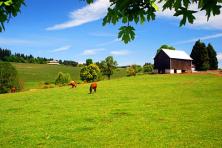The take-off of the biofuels industry over recent years has settled the question of whether biofuels could gain traction in a market dominated by petroleum giants. A combination of favorable public policies and ballooning oil prices has given biofuels a strong foothold which will almost certainly grow over coming years. Now the key questions center on what kind of biofuels industry will develop, and whether it will deliver on its promises for climate, rural development and energy security.
Two new reports seek to answer those questions by mapping pathways toward biofuels production that is environmentally, economically and socially sustainable. The reports focus on a specific region that is just ramping up its biofuels sector, the Pacific Northwest. This is appropriate for an economic sector tied to agriculture, where varying geographies make for starkly different products and economics. The reports demonstrate that issues of biofuels sustainability are being taken seriously by environmental advocates and agriculture analysts alike.
The most comprehensive overview of the issues is offered in Fueling Oregon with Sustainable Biofuels: A Report to the Oregon Environmental Council. The report is authored by Daniel Gilman, who has worked on international biofuels sustainability standards and helped create the Bioenergy Wiki, a valuable web resource overviewing the range of sustainability issues. The 51-page document represents a primer with general relevance. Its balanced, nuanced approach provides a good treatment of biofuels potentials and problems that biofuels critics and advocates alike should appreciate. Among topics covered are water use, soil erosion, forest and biodiversity concerns and net energy and greenhouse gas balance. The report then delves into Oregon biofuels feedstock potential, ranging from wheat to whey to farm residues and energy crops, and summarizes findings in a hugely useful two-page matrix.
The writing makes clear that not all biofuels are created equal. For instance, a corn ethanol plant fired by coal yields a product that offers no global warming pollution improvement over gasoline, whereas corn ethanol from a plant powered by biogas could cut greenhouse emissions in half. Cellulose-based biofuels produced from hybrid poplars could save around five metric tons of carbon dioxide emissions annually by replacing fossil fuels if they replaced existing crops. But if poplar plantations replace natural forests, it would take 16-35 years to make up for carbon dioxide released in deforestation.
The critical difference, the OEC document makes clear, is well-designed public policies. OEC has done leading-edge work to enact renewable fuel standards and incentives in Oregon, which arguably has one of the best state biofuels policy frameworks in the nation, ranking with leaders such as Minnesota, California and Washington. The new report sets out a policy agenda to take biofuels to the next stage in Oregon. It forms a good overall template for biofuels sustainability policies.
“First and foremost, Oregon should adopt a Low-Carbon Fuel Standard (LCFS),” the report recommends. “A LCFS requires all fuel producers to gradually reduce the greenhouse gas intensity of the fuels they sell, but doesn’t mandate how they meet the standard. It creates a high-value market for renewable fuels that provide the highest greenhouse gas improvements and associated environmental benefits.”
California led the way with adoption of an LCFS in 2006. Central to the concept is to account for greenhouse gases in the full production lifecycle from farm field to tank. A number of states including Oregon and Washington are now considering a similar policy.
Among other recommendations:
• Research and provide technical assistance for sustainable agricultural practices and low-water-use biofuels crops such as camelina.
• Provide incentives for biofuels plants that more efficiently use water and energy, and run with renewable energy, as well as for smaller-scale plants that use local waste products.
• Provide land conservation and carbon storage incentives for farmers competitive with incentives to produce other crops.
These flow out of a set of biofuels sustainability principles that cover the bases:
• Support only biofuels that reduce greenhouse gas emissions on a life-cycle assessment basis.
• Process biofuels with minimum fossil fuel inputs.
• Protect air and water quality.
• Grow biofuels feedstocks using sustainable agricultural practices.
• Conserve water.
• Protect biodiversity.
• Avoid conversion of native ecosystems.
• Support socially responsible and locally owned biofuels production.
• Provide consumer information.
The second report covers a broader geography, the entire Northwest, with a narrower focus, establishing oilseed crops to feed biodiesel production. Issues and Options in Northwest Bioenergy: Canola for Biodiesel, released by the Cascadia Carbon Institute, is authored by Institute President Steve Verhey and agronomist Denise Horton. Both are also associated with Ellensburg, Washington-based Central Washington Biodiesel, described in the report as “a rationally-sized biodiesel company.”
Whether or not that is a swipe at the presence of the nation’s largest biodiesel plant across the state, Imperium Renewables’ 100 million-gallon-per-year operation in Aberdeen, the report is explicit in judging that Northwest states have limited capacity to supply economically competitive oilseed crops. It focuses on canola, widely seen as having greatest Northwest potential.
Renewable fuels standard legislation passed in Oregon in 2007 and Washington in 2006 partly out of a hope that locally grown canola could feed a major regional biofuels industry. So far, apart from small operations such as Imperium’s Seattle facility and farm-based plants, on-the-ground reality has fallen short of the hope. If the report’s assessment is correct Northwest canola is caught in an economic bind that restricts its potential, and other crops should be considered in addition.
“Nearly all Northwest crops are more valuable than canola in most years, making farmers less likely to choose canola or other oilseed crops for purely economic reasons,” the authors write. “There is a narrow price window in which both canola production and biodiesel production from canola oil are profitable or attractive.”
But an important niche exists for canola, and the report’s prime contribution is to identify it and quantify its potentials.
“Oilseed crops cannot replace ‘money’ crops in most areas of the Northwest, but they do have significant value as rotation crops. Depending on market conditions, canola may be more valuable than currently popular rotation crops in dryland areas. As rotation crops, canola and mustards also have significant indirect value as they can reduce pesticide use, reduce soil erosion, reduce the need for field-burning, improve soil quality, and can simplify reduced-tillage farming methods.”
These have important additional benefits in cutting greenhouse emissions from farm operations, needed to build biofuels sustainability.
The authors underscore the economic challenge of canola with a telling comparison – “… acre for acre, the produce of both Washington and Oregon is about four times as valuable as Iowa’s produce.” Whereas Iowa’s low-revenue crops make it a biofuels center, the very strength of Northwest agriculture with its tremendous diversity of high-value crops disadvantages it in this realm.
The narrow window for economic returns shows in the numbers. Average canola yields in Washington, considered to have the best growing potential, generate 15 cents/pound, but the historic average price is 10 cents/pound. Canola prices have risen above average lately to 18 cents as of September 2007. But this only generates returns competitive with wheat at $6.50/bushel. With wheat prices running well above that the incentive to grow wheat instead. And even 15-cents/pound canola drives biodiesel production to $3.85 per gallon, economically challenging even with current petroleum prices.
These economic facts underscore that canola cannot be the ‘money’ crop, so rotational value will drive cultivation – “… canola may find a place as a rotation crop in virtually all areas.” It helps control weeds, pathogens and pests, reduces erosion and improves soil quality. Its deep roots penetrate soils, breaking up compacted soils, making low-till and no-till cropping easier.
The report finds canola’s niche in replacing current rotations of barley, dry peas and lentils, and focuses its quantification on Washington. (Idaho and Oregon potential are more limited and difficult to quantify, the authors note.) With 15 cents/pound canola and average prices for the other crops, canola can be more profitably harvested on around 600,000 acres. The canola rotation can only take place once every four years, to avoid canola’s own pests and pathogens. That would yield 16 million gallons of oil production annually. This would go a long way to meet the state’s two-percent biodiesel standard of 20 million gallons, but would only feed around 13 percent of state biodiesel plant capacity. And cost challenges could limit rotation to replacing lower-value lentils and dry peas, cutting the potential nearly in half to 8.8 million gallons.
Verhey and Horton note that camelina, a canola relative, could also produce Northwest oils. With the reported capacity to outcompete weeds and generate high yields even in dryland areas with 10 inches annual rainfall, as well as few or no fertilizer needs, camelina has drawn a lot of attention around the region. It could grow in now marginal farmlands, but the authors caution that other values including habitat and carbon sequestration need to be taken into account before land is converted.
They note that soil organic carbon of 22-50 metric tons has been observed on Conservation Reserve Programs in the Palouse. If that land is plowed for biodiesel crops it could take at least 18 years to make up for carbon releases. This underscores the importance of the OEC report’s call for competitive payments to farmers to “grow” soil carbon.
Despite this limited capacity, the authors conclude, “… it is possible – and desirable – to develop a true Northwest biodiesel industry. Such an industry will use regionally produced animal fats, oil from algae, second-use oils, and farm-raised oils such as canola oil.” The report recommends a number of steps to make this happen:
• Brand and certify Northwest canola biodiesel as a regionally grown product and use it to fuel public fleets.
• Create state incentives for use of recycled oils from food-processing. (Current incentives favor first-use oils.)
• Provide state canola crop payments to make up the difference between market prices and cost of production.
• Develop regional oilseed processing facilities to improve economics for sale of its animal feed coproduct – 60 percent of canola seed weight and “an important part of the profitability equation …”
• Develop carbon credits to favor the superior greenhouse gas reductions of biodiesel produced from feedstocks not transported over long distances.
Both the OEC and Cascadia Carbon Institute reports represent significant contributions to efforts aimed at building a sustainable Northwest biofuels industry. Each makes clear there are significant economic and environmental challenges, and serious pitfalls to be avoided. Each also emphasizes that successfully meeting these challenges is a worthy endeavor. They affirm it is indeed possible to grow and produce biofuels in a broadly sustainable manner with the right mix of public policies and partnerships. The benefits will be healthier rural economies, improved farm economics and agronomics, greater energy security and reduced global warming pollution. These benefits will not happen without making conscious public policy choices, and these reports offer a good roadmap to those choices.
Patrick Mazza is Climate Solutions Research Director. This is part of a Growing Sustainable Biofuels series available at www.harvestcleanenergy.org.



